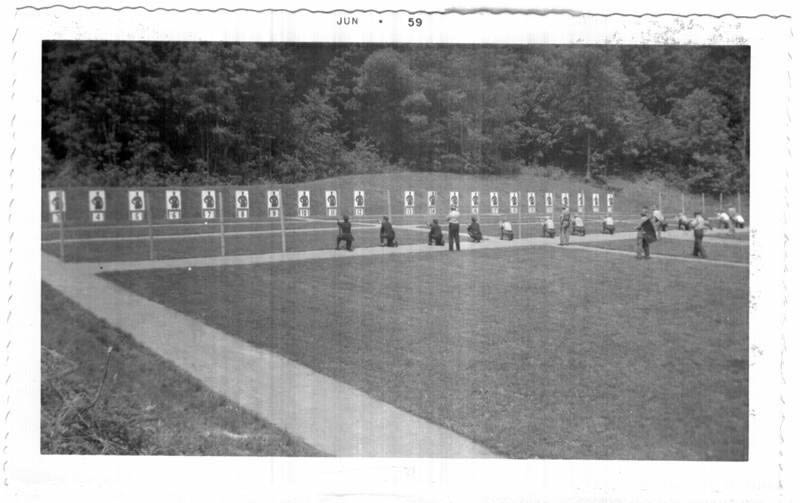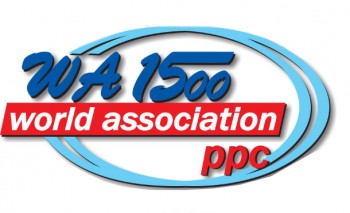The Origins of PPC...
In 1957/58 the Department of Police Administration at University of Indiana, (Bloomington, Indiana), developed a handgun course that was more suited to Police training. Prior to that point, all Police handgun training was done "Civilian" style... one handed, single action, on a Bullseye target. Colt had developed a man sized target with all areas of the body counting as a hit and worth points: 5, 4, 3 and 2 (for arms). This target was modified for competition use and included two vertical lines, three and one half inches apart, extending from the point of the chin to the bottom of the 5 ring. There was also a six inch circle in the center of the chest. This entire area was designated as the 5-X ring and was used to break possible ties.
In September of 1958 the Assistant Director of Police Training at the University of Indiana, asked the Colt Patent Firearms Company to host the first International Shoot, at the University Range. They agreed and the first Match was held in June of 1959 with 429 Police Officers from 22 American States, 4 from Puerto Rico and 6 from Canada (Winnipeg Police Dept.) attending.


The University was so impressed by the attendance that they hosted the match again in 1960 and 1961, in association with Colt. For a look at the Match Flyer from the 1960 tournament. Interesting to note there was no registration or entry fee for the tournament. Also, notice the original course of fire... 5 shot strings (not 6 as we use today)... hip shooting at 7 yards... loading done from rounds in the pocket... stage 4 shot prone from 60 yards in 35 seconds.
See the 1960 Match FlyerIn 1961 Winnipeg Police hosted the first Canadian PPC competition (at the Miller Road Range)
In 1962 the National Rifle Association (NRA) expanded its' program to include police shooting competitions and joined with the Department of Police Administration at Indiana University to conduct a revised and renamed shooting tournament.
The 1962 National Police Pistol Championships and Firearms Instructors' Course was held August 22 to 26, 1962.
1962 Tournament Match BookletReading through the booklet you'll notice a number of interesting items...
-
Total "package" price to shoot all the matches was $8.50 plus $2.00 registration fee
-
Loading: "All loading will be with cartridges taken from the competitor's pocket. A competitor will have in his possession only the number of rounds of ammunition required for the match being fired..."
-
Crouch Shooting: "The position used at 7 yards stipulates a position which is commonly referred to as 'hip shooting'. In this position the gun must be supported by one hand only and held below shoulder level. The arm holding the gun must be visibly bent at the elbow."
-
There were six matches outlined... if you look closely at the specific courses of fire you'll see the early beginnings of what was to become today's 1500 Aggregate Match.
-
The shot strings went from 5 (as had been used by Colt the previous three years) to 6
- The 60 yard prone stage was changed to 50 yards.

By the following year (1963) the NRA's police programs had expanded to include a variety of elements: affiliation of law enforcement agencies, certification of Police Firearms Instructors, registration of Police Qualification Courses and registration and approval of Police Pistol Tournaments.
The 1963 tournament program shows how quickly the rules and format was changing (even from the previous year's event).
1963 tournament programA number of noteworthy examples are:
-
Loading was now allowed: "with cartridges taken from the competitor's pocket, cartridge belt or special pouch. Cartridge belts and special pouches may be used if they are practical for police duty use..."
-
Courses of fire now specified Matches #1 through Match #5 and an Aggregate Match #6 which was used to determine the National Individual Police Pistol Combat Championship (i.e. our present day 1500 Aggregate match).
-
Match #1 was essentially the same as today's Match 1 except that it was fired in 25 seconds (remember this pre-dates speedloaders) and it was fired using the Crouch position.
-
Match #2 was identical to today's version (18 rounds in 90 seconds fired from 25 yards, kneeling, standing left barricade and standing right barricade)... except no speedloaders, reloads were by hand.
-
Match #3 was also the same as today (24 rounds in 165 seconds fired from 50 yards, sitting, prone, standing left barricade and standing right barricade).
-
Match #4 introduced 25 yard standing without support. As we do today, two stages of 12 rounds in 35 seconds from 25 yards standing unsupported... once again they didn't have speedloaders so the 35 seconds included the time to reload by hand from the pocket, or cartridge belt or pouch.
- Match #5 was also adjusted to incorporate this new 25 yard standing unsupported stage (eliminating the original Colt 60 yard prone stage). Match #5 which was renamed the "Modified Practical Pistol Course Match" now looked like today's familiar Match 5 with the exception that the first stage allowed 25 seconds (later shortened to 20 seconds with the advent of speedloaders) and required the use of the Crouch position (not sighted fire).
PPC has had several handles over the years. In the past it was known as Practical Police Course, Practical Pistol Course, Practical Pistol Combat and what the NRA currently terms Police Pistol Combat. It is interesting that the word Pistol was often part of the name, even though this was primarily a revolver sport until approximately 1990 when the Semi-Autos came on the scene. The format has developed over the past 40+ years, creating a venue in which officers compete and compare their abilities, to promote skill development and proficiency.
The front cover of the current NRA PPC Rule Book still reads:
"The intent of police competition is to provide the Police Officer a competitive program which will improve the officer's skill and competence as a law enforcement professional."
In 1972 the Canadian Police Combat Association (CPCA) was formed and became the national governing body for Police Combat Shooting in Canada.
Our thanks to Stan Smyth, Winnipeg PD - Retired, for loaning us the historic pictures and brochures, and for giving us a first hand account of how it all began, right "from the horses mouth" so to speak.
History of the CPCA
1972
Established 1972
Since 1972 the Canadian Police Combat Association has been actively involved in the development, promotion and support of police combat shooting in Canada.1977
Federal Letters Patent
CPCA receives it's Federal Letters Patent, formally recognizing it as the national governing body for Police Combat shooting.
Objectives of the Corporation were established as:
- To promote, foster and perpetuate Police Combat shooting in Canada
- To co-ordinate and assist, where possible, Police Combat shooting competitions and championships in Canada
- To speak as a united voice insofar as Police Combat shooting is concerned
- To act as a liaison between all Canadian Police Department shooting organizations
1989
Civilian Participation
CPCA welcomes Civilian shooters as full participating members.
Today, civilians make a large portion of our total membership.
Civilian shooters are well represented in every classification... from Marksman all the way up to and including Grand Master!
2001
Breaking Borders

The World Association 1500 (WA1500ppc) invites the CPCA to join 14 other countries to participate in their annual tournaments around the world.
Learn more about the WA1500
2002
Commitment to Safety
CPCA develops and launches a new National Instructor Certification Program. This program is a logical extension of our mandate to promote growth and safety in the sport. It also demonstrates our commitment to police combat shooting and to its' future.2012
Going Digital
The CPCA launches it's website sharing event results across the country, later showing leader boards for the top competitors and statistics.
2020
Today
The CPCA continually supports individuals wanting to learn competitve shooting by providing training and hosting competitions across the country.
Every one of our members has a voice to be heard and opportunity to excel in the sport. We welcome your interest and invite you to join us in our efforts.
